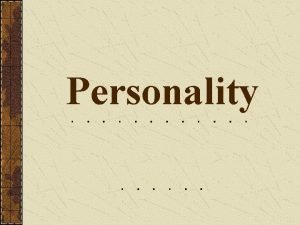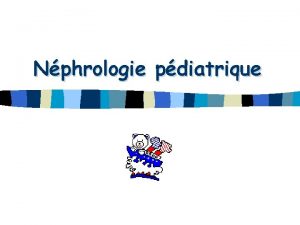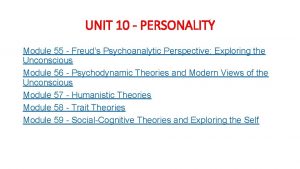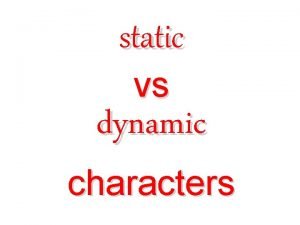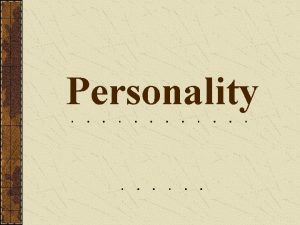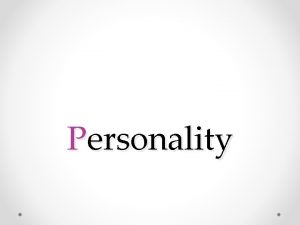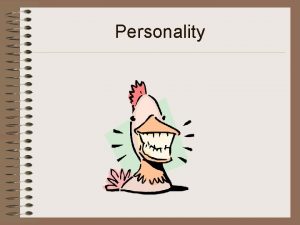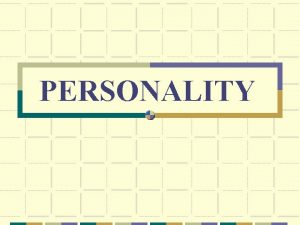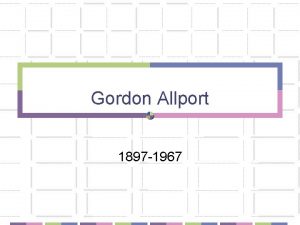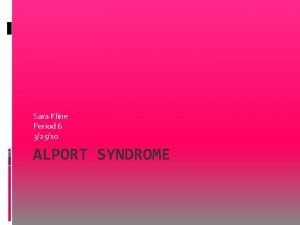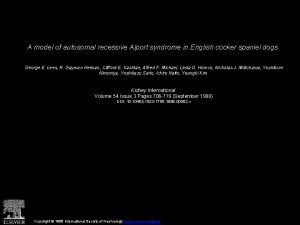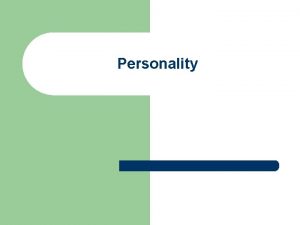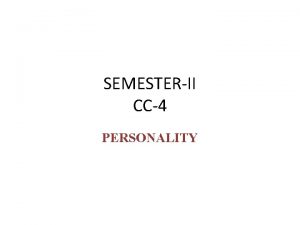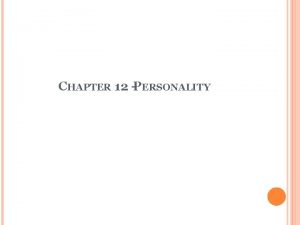Personality Gordon Alport defined personality as the Dynamic














































- Slides: 46

Personality

Gordon Alport defined personality as the; “Dynamic organization within the individual of those psychophysical systems that determine his or her unique adjustment to the environment”

Personality = temperament + character + intelligence

Basic functions of personality are : to feel, to think, and to perceive, and to incorporate these into purposeful behaviors.

Regarding BEHAVIOUR: Temperament HOW Character WHAT WHY

Four major temperament traits have been identified: Harm avoidance ﺩﻭﺭی ﺍﺯ ﺧﻄﺮ Novelty seeking ﺗﻨﻮﻉ ﻃﻠﺒی Reward dependence ﻭﺍﺑﺴﺘگی ﺑﻪ ﻧﻈﺮ ﺩیگﺮﺍﻥ Persistence ﻣﺪﺍﻭﻣﺖ

Ancient four temperaments: Melancholic (harm avoidance), Choleric (novelty seeking), Sanguine (reward dependence), and Phlegmatic (persistence).



Character

Character Self – directedness Cooperativeness Self - transcendence



DSMIV-TR defines personality disorders as: An enduring pattern of inner experience and behavior that deviates markedly from the expectations of the individual`s culture.

Personality disorder is manifested in two (or more) of the following areas: 1. Cognition (i. e. ways of perceiving and interpreting self, other people, and events) 2. Affectivity (i. e. the range, intensity, liability and appropriateness of emotional response) 3. Interpersonal functioning 4. Impulse control

The pattern is stable and of long duration and its onset can be traced back at least to adolescence or early adulthood.

It is inflexible and pervasive across a broad range of personal and social situations and leads to clinically significant distress or impairment in social, occupational or other important areas of functioning.

Cluster A (detachment, reward dependence) Schizoid Paranoid schizotypal

Cluster B (impulsivity, novelty seeking) Borderline Antisocial Histrionic Narcissistic

Cluster C (fearfulness, harm avoidance) Avoidant Dependent Obsessive - compulsive

Personality disorders are ego-syntonic and Alloplastic

Schizoid p. d Social detachment and restricted range of expressed emotions


Men> Women 7. 5% of general population may progress to delusional disorder or schizophrenia

Paranoid p. d Excessive suspiciousness and distrust of others Men > Women 0. 5 -2. 5% in general population may progress to delusional disorder


Schizotypal p. d. Social and interpersonal deficit plus cognitive and perceptual disturbances and eccentric behavior


Sex. Ratio is unknown 3 percent of gen. pop May progress to schizophrenia, delusional disorder, brief psychotic disorder

Borderline p. d Instability of affects , self – image, interpersonal relationships + marked impulsiveness Female > male 2 percent of g. p. are at increased risk M. D. D , substance abuse and eating disorder


Antisocial p. d Disregard for and violation of rights of others Male > Female 1 -3 percent of g. p.


Narcissistic p. d Sense of grandiosity, need for admiration lack of empathy, chronic intense envy M>F 1% of g. p.


Histrionic p. d. Self – dramatization , excessive emotionality and attention seeking F>M 2 -3% of g. p.


Avoidant p. d hypersensitivity to negative evaluation, social inhibition and feelings of inadequacy. F=M 0. 5 -1 of g. p.


Dependent p. d Excessive need to be taken care, clinging behavior, submissiveness, fear of separation, interpersonal dependency. F=M most frequent of p. d. s


Obsessive – compulsive p. d. Preoccupation with orderliness, perfectionism mental and interpersonal control. M>F 1% of g. p.


Treatment: Psychotherapy pharmacotherapy

Pharmacotherapy: Aggression Low dose antipsychotic Lithium SSRIS Auticonvulsants B-Blockers Emotional liability Lithium antipsychotics

Depression Antidepressants Emotional detachment Atipical antipsychotics Anxiety SSRIS MAOIS BZDs B-Blockers Low dose antipsychotics Psychotic symptoms Antipsychotics
 Gordon alport
Gordon alport Caillots
Caillots A collection of well-defined object
A collection of well-defined object How is personality defined module 55
How is personality defined module 55 Transferered
Transferered Dynamic approach to personality
Dynamic approach to personality Dynamic character example
Dynamic character example đặc điểm cơ thể của người tối cổ
đặc điểm cơ thể của người tối cổ Tỉ lệ cơ thể trẻ em
Tỉ lệ cơ thể trẻ em Vẽ hình chiếu vuông góc của vật thể sau
Vẽ hình chiếu vuông góc của vật thể sau Các châu lục và đại dương trên thế giới
Các châu lục và đại dương trên thế giới Thế nào là hệ số cao nhất
Thế nào là hệ số cao nhất Hệ hô hấp
Hệ hô hấp ưu thế lai là gì
ưu thế lai là gì Các môn thể thao bắt đầu bằng tiếng bóng
Các môn thể thao bắt đầu bằng tiếng bóng Tư thế ngồi viết
Tư thế ngồi viết Cái miệng nó xinh thế
Cái miệng nó xinh thế Hát kết hợp bộ gõ cơ thể
Hát kết hợp bộ gõ cơ thể Mật thư tọa độ 5x5
Mật thư tọa độ 5x5 Tư thế ngồi viết
Tư thế ngồi viết Voi kéo gỗ như thế nào
Voi kéo gỗ như thế nào Thẻ vin
Thẻ vin Thể thơ truyền thống
Thể thơ truyền thống Các châu lục và đại dương trên thế giới
Các châu lục và đại dương trên thế giới Sự nuôi và dạy con của hổ
Sự nuôi và dạy con của hổ Từ ngữ thể hiện lòng nhân hậu
Từ ngữ thể hiện lòng nhân hậu Diễn thế sinh thái là
Diễn thế sinh thái là Slidetodoc
Slidetodoc V. c c
V. c c Vẽ hình chiếu vuông góc của vật thể sau
Vẽ hình chiếu vuông góc của vật thể sau 101012 bằng
101012 bằng Lời thề hippocrates
Lời thề hippocrates Chụp phim tư thế worms-breton
Chụp phim tư thế worms-breton đại từ thay thế
đại từ thay thế Quá trình desamine hóa có thể tạo ra
Quá trình desamine hóa có thể tạo ra Công thức tính độ biến thiên đông lượng
Công thức tính độ biến thiên đông lượng Thế nào là mạng điện lắp đặt kiểu nổi
Thế nào là mạng điện lắp đặt kiểu nổi Các loại đột biến cấu trúc nhiễm sắc thể
Các loại đột biến cấu trúc nhiễm sắc thể Bổ thể
Bổ thể Vẽ hình chiếu đứng bằng cạnh của vật thể
Vẽ hình chiếu đứng bằng cạnh của vật thể Biện pháp chống mỏi cơ
Biện pháp chống mỏi cơ độ dài liên kết
độ dài liên kết Khi nào hổ mẹ dạy hổ con săn mồi
Khi nào hổ mẹ dạy hổ con săn mồi Thiếu nhi thế giới liên hoan
Thiếu nhi thế giới liên hoan Chúa sống lại
Chúa sống lại điện thế nghỉ
điện thế nghỉ Một số thể thơ truyền thống
Một số thể thơ truyền thống
